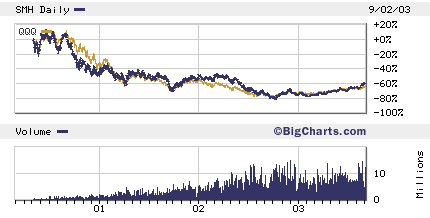Risk at the Micro Level, the S&P
Yesterday I said I'd look at risk at the micro level. I didn't mean the household or individual level (although that would be worth doing to). Instead, I meant at the single stock level. Where are the biggest risks? Well... Forbes listed the top 10 best-performing stocks on the S&P 500 for August. The index itself was up only 1.8% in August. But that was good enough for its highest monthly close in a year. And it looked like a good place to start evaluating who has the most to lose as the month progresses. You’d think the S&P would act more like an industrial index. But in order to compete with the Nasdaq and the Dow, the S&P has reshuffled its membership in the last few years…adding the high-performing tech issues and dropping the old economy dinosaurs. The net effect is the S&P is now responsive to trends in technology spending, or even investor sentiment about technology. For example, the Bureau of Economic Analysis reports that in the second quarter, sales of computer equipment were up 27%. That translated into five of the top 10 gaining stocks in August coming from the semiconductor and computer equipment sectors. Here are the top ten S&P winners for August: Advanced Micro Devices (AMD), up 54.7%, Williams (WMB), up 43.8%, Network Appliance (NTAP) up 39%, Novell (NOVL) up 39%, Broadcom (BRCM) up 34%, National Semiconductor (NSM) up 30%, Goodyear Tire and Rubber (GT) up 29%, Texas Instruments (TXN) up 26%, Dollar General (DG) up 24%, and LSI Logic (LSI) up 24%. Now the fact that they were the biggest gainers in August doesn’t make each of these ten stocks AUTOMATICALLY risky for September, IF September turns out to be historically bad. But I would, ominously as possible, note the dominance of chip stocks. Semiconductor bulls are a little like perma bears. They persistently make a claim, often in the face of clear evidence to the contrary. This is NOT being contrarian at all. It’s stubborn. And expensive. The only relevant consideration for the semis is whether business spending on IT is going to absorb the amount of productive capacity already in the sector. I haven’t seen any evidence that shows it will…and that’s IF business spending on tech picks up--something the semi conductor bulls assume is just a matter of time. But even if you looked at it only in terms of fundamentals, there would be a lot to fear from semis. The entire industry trades at 60 times earnings and 5 times book value. And as if that wasn’t enough, look the chart blow. Semis Track the Nasdaq
 Tellingly, the SMH (the semiconductor holders) debuted in March of 2000--right at the top of the Nasdaq. Even though they look like a bargain relative to those levels, the reality is that at current multiples, they’re still toxic. And to the extent that they, and other tech stocks, have accounted for the improved performance of the S&P over the summer, the index and the market have an awfully slender reed to lean on.
Tellingly, the SMH (the semiconductor holders) debuted in March of 2000--right at the top of the Nasdaq. Even though they look like a bargain relative to those levels, the reality is that at current multiples, they’re still toxic. And to the extent that they, and other tech stocks, have accounted for the improved performance of the S&P over the summer, the index and the market have an awfully slender reed to lean on.

0 Comments:
Post a Comment
<< Home